Abstract
Background:
Cancer of breast is most common cancer among women in India and vast majority of countries worldwide. While undergoing chemotherapy for carcinoma management, women encounter side effects, which affects their quality of life (QOL). A randomized controlled study with quantitative research approach and time series design was conducted, to study the effectiveness of yoga on QOL of breast cancer patients undergoing chemotherapy.
Methodology:
One hundred breast cancer patients scheduled for 3-weekly, day-care adjuvant chemotherapy (CEF regimen) were enrolled with consecutive sampling technique, into control (n = 52) and experiment (n = 48) groups, by concealed randomization following written informed consent. Baseline data on QOL were collected before first-cycle chemotherapy using the European Organization for Research and Treatment of Cancer QLQ C30. Patients in the experimental group were taught diaphragmatic breathing techniques, systematic relaxation, and alternate nostril breathing, and Joints and Glands neck and shoulder exercises were instructed to practice twice daily at home. They were supervised in practicing these techniques while they received second, third, fourth, fifth, and sixth cycles of chemotherapy in the day-care facility. Participants in the control group received only routine care. All participants received standard post chemotherapy prescription. Data on QOL were collected from all patients during the second, third, fourth, fifth, and sixth cycles of chemotherapy.
Results:
The analysis revealed that at the baseline (first chemotherapy cycle), breast cancer patients in control and experimental groups were homogeneous in terms of their sociodemographic and clinical variables and QOL score. Yoga practices were effective in improving the QOL of breast cancer patients in the experimental group in the areas of global health status, physical function, role function, and emotional function and decreasing the symptoms of fatigue, insomnia, loss of appetite, and constipation, during the period of chemotherapy.
Conclusion:
Yoga practices comprising of relaxation techniques reduce many side effects and improve the QOL of women undergoing chemotherapy for breast cancer.
Keywords: Breast cancer, chemotherapy, quality of life, yoga
INTRODUCTION
Globocan 2018 report, estimated having about 2.1 million newly diagnosed female breast cancer cases in 2018, accounting for almost 1 in 4 cancer cases among wome.[1] Treatment of cancer and cancer itself causes many side effects and complications, which influence the quality of life (QOL) and cause a considerable alteration in health-related QOL.[2] Women with breast cancer undergo treatment with various modalities such as surgery, chemotherapy, and radiotherapy. Among these, the lengthiest treatment is chemotherapy as it is given every 21 days in six to eight cycles. While going through the cycles of chemotherapy, breast cancer patients experience many side effects such as nausea, vomiting, weakness, anemia, fatigue, and alopecia. Breast surgery such as mastectomy and alopecia secondary to chemotherapy disturb the body image of women, leading to psychological distress. These side effects and psychological stress adversely affect the coping mechanisms of breast cancer patients and decrease their QOL.
Recent studies on complementary therapy such as yoga for patients undergoing chemotherapy are emerging as supportive therapy for cancer patient management. Based on the review of literature, the investigator recognized that none of the earlier researches actually investigated the effectiveness of yoga on QOL of breast cancer patients across all the six cycles of chemotherapy.
The study aimed to assess the effectiveness of relaxation techniques used in yoga such as diaphragmatic breathing, systematic relaxation, alternate nostril breathing, and exercises for joints and glands, on the QOL of breast cancer patients receiving six cycles of chemotherapy.
METHODOLOGY
Research design
Quantitative research approach was used in this randomized controlled study with time series design.
Setting of the study
The study was conducted at a comprehensive cancer care center in Dehradun, Uttarakhand State, India.
Sample
One hundred female breast cancer patients undergoing adjuvant chemotherapy following surgery, scheduled for six, three-weekly cycles of CEF chemotherapy regimen, constituted the study sample.
Sampling technique
Consecutive sampling technique was adopted to enroll eligible patients scheduled for day-care chemotherapy; the participants were grouped into control and experimental arms by concealed randomization using sealed numbered envelopes.
Inclusion criteria
Female breast cancer patients of all ages who have undergone breast surgery as primary treatment and were scheduled for receiving adjuvant chemotherapy, who agreed to take part in the study and who were not practicing yoga earlier, who could follow instructions related to yoga in Hindi language, who were willing to practice yoga regularly at home, and who had Zubrod's performance status score 0–2 that they were able to walk about more than 50% of the time were included in the study.
Breast cancer patients having any known distant metastasis and those who received chemotherapy or radiotherapy earlier were excluded from the study.
Study tools
The Eastern Cooperative Oncology Group (Zubrod) performance scale and Hindi Version of European Organization for Research and Treatment of Cancer QOL-C30 Tool (version 3) were used to collect the data.
Institutional ethics committee approval was obtained prior to enrollment, and informed written consent was taken from each participant.
Data collection procedure/study protocol
All participants had Zubrod's performance status score between 0 and 2 at the time of enrollment in the study. The eligible participants were identified based on the inclusion and exclusion criteria and randomized into control and experimental groups by concealed randomization. During the first cycle of chemotherapy, the purpose of the study and process of data collection were explained to the patients and their accompanying relatives. Thereafter, the written consent was taken from patients and their relatives. Assurance was given regarding confidentiality of their information, and they were permitted to leave the study whenever they wished. Thereafter, the sociodemographic pro forma and QOL questionnaire QLQ-C30 were given to the participants in the experimental and the control group to fill. All patients who could read and understand the Hindi language filled the questionnaire by themselves. Assistance was given to the study participants, who could not read Hindi, in filling the questionnaire by reading the questionnaire to them and asking them to tick the option best suited them.
Following that, the investigator explained the benefits of performing yoga during the period of receiving chemotherapy to patients in the experimental group and taught them yoga by demonstrating the steps of diaphragmatic breathing, systematic relaxation, alternate nostril breathing, and neck and shoulder exercises. The return demonstration was done by participants in front of the investigator. The researcher spent 2 h with the study participants who were in the experimental group during the first cycle of chemotherapy. The researcher provided each one of them a booklet on “Yoga during chemotherapy” which contained information regarding the steps of performing diaphragmatic breathing, systematic relaxation, alternate nostril breathing, and joint and gland exercises of neck and shoulder, in words and pictorial form. The participants were asked to practice the above-mentioned steps twice daily (morning and evening) at home and to maintain a record of the same.
The investigator met the participants of both groups when they came after 21 days for their second, third, fourth, fifth, and sixth cycles of chemotherapy and gave them Hindi versions of QLQ-C30 questionnaire to fill and after that supervised the patients who were in the experimental group in practicing diaphragmatic breathing, systematic relaxation, and alternate nostril breathing while they were receiving chemotherapy in the day-care unit.
Reminder calls were made to the participants in the experimental group once a week on every Wednesday, being the mid-day of the week to remind them about the continuation of yoga practice.
The patients in the experimental group and control group were assigned beds separately at the day-care center, in order to prevent influence.
Patients in the control group received routine care which included instructions, regarding diet to be taken and other aspects of self-care after chemotherapy.
The investigator followed each of the study participants in both groups for 4 months throughout the six cycles of chemotherapy.
RESULTS
Data were analyzed by using statistical software SPSS (version 20) Dehradun, Uttarakhand, India. Categorical data were expressed as frequency and percentage. Kolmogorov–Smirnov test was used to check the normality of data.
For the Global Health Status (GHS) scale and Functioning Scales, a higher score represented a better QOL and lower score to a poor QOL.
Symptom scales
The higher score correspond to greater symptoms, indicating a poor QOL. Lower scores represented fewer symptoms and indicated a better QOL.
Out of the 100 breast cancer patients, more than half (65.38%) belonging to the control group and half of the experimental group (52.8%) were premenopausal. Less than half were postmenopausal (34.61%) in the control and 47.92% in the experiment group. The majority (98.08%) in the control group and 51 participants (93.75%) in the experimental group were diagnosed with infiltrating ductal carcinoma. The majority in the control (76.92%) and in the experiment group (85.42%) were having breast cancer for <1 year. The majority (94.23%) of the sample in the control and in the experimental group (93.75%) had surgery, i.e., modified radical mastectomy. More than half of the sample (65.38%) in the control and experimental groups (58.33%) had received fluorouracil (5-FU), epirubicine, and cyclophosphamide regimen of chemotherapy.
Clinical variables of the study participants in the control and experimental groups had no significant difference. Only one variable, i.e., grade of cancer, was statistically significant (P = 0.026) between the groups. Hence, it could be interpreted that breast cancer patients in both groups were homogeneous in relation to their clinical variables, suggesting that patients in both groups were from the same population.
Effectiveness of yoga on European Organization for Research and Treatment of Cancer Quality of Life C-30 of breast cancer patients undergoing chemotherapy
At the baseline, patients in the control and the experimental groups were having almost similar QOL scores; no significant difference existed among the groups.
The mean GHS scores of the control group reduced significantly from the baseline in the second, third, fourth, fifth, and sixth cycles. A slight increase was observed in the sixth cycle. The experimental group's average scores reduced significantly from the baseline score in the third cycle. The experimental group had statistically significant difference from the control group in the second, third, fourth, fifth, and sixth cycles (P = 0.03, P = 0.03, P = 0.003, P = 0.000, and P = 0.001, respectively). Therefore it could be inferred that as participants in the experimental group continued practicing yoga, their GHS scores improved during the period of chemotherapy [Table 1].
Table 1.
Comparison of quality of life European Organization for Research and Treatment of Cancer quality of life tool C-30 Global Health Status within and between control group and experimental group of breast cancer patients undergoing chemotherapy
| Chemotherapy cycles and number of patients in the control and experimental groups | Global health status | |||
|---|---|---|---|---|
| Mean±SD Median (minimum-maximum) | Difference (95% CI) | P* Mann-Whitney Test | ||
| Control group | Experimental group | |||
| Cycle I (n=100) | 64.26±7.62 66.66 (50-83.33) | 66.14±9.16 66.66 (50-83.33) | −1.88 (−5.21-1.45) | 0.263 |
| Control=52 | ||||
| Experiment=48 | ||||
| Cycle II (n=98) | 59.96±10.93 58.33# (33.33-83.33) | 65.78±12.79 66.66 (33.33-100) | −5.81 (−10.57-−1.05) | 0.0306** |
| Control=51 | ||||
| Experiment=47 | ||||
| Cycle III (n=96) | 58.66±11.65 58.33# (33.33-83.33) | 62.86±8.90 58.33# (33.33-83.33) | −4.19 (−8.42-0.036) | 0.0362** |
| Control=50 | ||||
| Experiment=46 | ||||
| Cycle IV (n=93) | 56.38±14.13 50# (33.33-100) | 65.21±10.58 66.66 (41.66-83.33) | −8.83 (−13.98-−3.68) | 0.0003** |
| Control=47 | ||||
| Experiment=46 | ||||
| Cycle V (n=84) | 56.74±11.38 54.16# (33.33-83.33) | 68.45±10.65 66.66 (33.33-83.33) | −11.70 (−16.49-−6.91) | 0.0000** |
| Control=42 | ||||
| Experiment=42 | ||||
| Cycle VI (n=83) | 59.32±13.04 58.33# (25-83.33) | 69.10±15.05 66.66 (0-83.33) | −9.78 (−15.92-−3.63) | 0.0001** |
| Control=42 | ||||
| Experiment=41 | ||||
| P value Friedman test | <0.0001 | <0.0001 | ||
*P<0.05, **Significant, #Wilcoxon signed-rank test (significant). SD: Standard deviation, CI: Confidence interval
Physical function mean scores of the control group declined significantly from the baseline score in the second, third, fourth, fifth, and sixth cycles. However, the mean scores of the experimental group declined significantly from the baseline score in the fourth cycle only. The experiment group had statistically significant difference from the control group in third, fifth, and sixth cycles (P = 0.007, P = 0.0002, and P = 0.0007, respectively) [Table 2].
Table 2.
Comparison of quality of life C-30 functional scales-physical function, within and between control group and experimental group of breast cancer patients undergoing chemotherapy
| Chemotherapy cycles and number of patients in the control and experimental groups | Physical function | |||
|---|---|---|---|---|
| Mean±SD Median (minimum - maximum) | Difference (95% CI) | P* Mann-Whitney Test | ||
| Control group | Experimental group | |||
| Cycle I (n=100) | 72.30±8.49 73.33 (60-86.66) | 72.63±5.71 73.33 (60-80) | −0.33 (−3.22-2.56) | 0.503 |
| Control=52 | ||||
| Experiment=48 | ||||
| Cycle II (n=98) | 64.96±15.36 66.66# (20-93.33) | 71.06±13.06 73.33 (33.33-100) | −6.09 (−11.83-−0.35) | 0.0523 |
| Control=51 | ||||
| Experiment=47 | ||||
| Cycle III (n=96) | 60.26±18.01 60# (13.33-93.33) | 69.13±15.41 73.33 (20-93.33) | −8.86 (−15.68-−2.03) | 0.0074** |
| Control=50 | ||||
| Experiment=46 | ||||
| Cycle IV (n=93) | 57.73±23.02 60# (13.33-100) | 66.37±14.53 70# (20-86.66) | −8.64 (−16.59-−0.69) | 0.0720 |
| Control=47 | ||||
| Experiment=46 | ||||
| Cycle V (n=84) | 54.28±19.51 53.33# (20-93.33) | 69.84±15.94 73.33 (33.33-93.33) | −15.55 (−23.28-−7.82) | 0.0002** |
| Control=42 | ||||
| Experiment=42 | ||||
| Cycle VI (n=83) | 53.80±20.42 53.33# (6.66-100) | 68.45±16.26 73.33 (26.66-93.33) | −14.64 (−22.72-−6.57) | 0.0007** |
| Control=42 | ||||
| Experiment=41 | ||||
| P value Friedman test | <0.0001** | <0.0001** | ||
*P<0.05, **Significant, #Wilcoxon signed-rank test (significant). SD: Standard deviation, CI: Confidence interval
The results revealed that control group's role function mean scores reduced significantly from the baseline score in the second, third, fourth, fifth, and six cycles. The experimental group's mean scores were similar to the baseline scores all through the six cycles of chemotherapy. Statistically significant difference between experimental and control groups was in the second, third, fourth, fifth, and sixth cycles of chemotherapy (P = 0.01, P = 0.03, P = 0.003, P = 0.0001, and P = 0.0003, respectively) [Table 3].
Table 3.
Comparison of quality of life C-30 Functional Scales - role function, within and between control group and experimental group of breast cancer patients undergoing chemotherapy
| Chemotherapy cycles and number of patients in the control and experimental groups | Role function | |||
|---|---|---|---|---|
| Mean±SD Median (minimum - maximum) | Difference (95% CI) | P* Mann-Whitney Test | ||
| Control group | Experimental group | |||
| Cycle I (n=100) | 66.98±14.19 66.66 (50-100) | 69.09±11.90 66.66 (33.33-83.33) | −2.11 (−7.33-3.11) | 0.182 |
| Control=52 | ||||
| Experiment=48 | ||||
| Cycle II (n=98) | 59.15±23.64 50# (33.33-100) | 71.27±24.50 66.66 (16.66-100) | −12.12 (−21.78-2.47) | 0.0124** |
| Control=51 | ||||
| Experiment=47 | ||||
| Cycle III (n=96) | 56±23.0250# (16.66-100) | 66.30±25.69 66.66 (0-100) | −10.30 (−20.17-0.43) | 0.0315** |
| Control=50 | ||||
| Experiment=46 | ||||
| Cycle IV (n=93) | 53.19±24.23 50# (0-100) | 66.30±23.95 66.66 (0-100) | −13.11 (−23.04-3.18) | 0.0038** |
| Control=47 | ||||
| Experiment=46 | ||||
| Cycle V (n=84) | 50.79±21.76 50# (0-100) | 70.23±23.72 66.66 (0-100) | −19.44 (−29.32-9.56) | 0.0001** |
| Control=42 | ||||
| Experiment=42 | ||||
| Cycle VI (n=83) | 51.58±20.76 50# (16.66-100) | 70.32±23.72 66.66 (16.66-100) | −18.73 (−28.46-9.00) | 0.0003** |
| Control=42 | ||||
| Experiment=41 | ||||
| P value Friedman test | <0.0001** | <0.0001** | ||
*P<0.05, **Significant, #Wilcoxon signed-rank test (significant). SD: Standard deviation, CI: Confidence interval
Emotional function mean scores of the control and experimental groups reduced significantly from the baseline score in the third, fourth, fifth, and sixth cycles. The decrease in scores was more in the control group than that in the experimental group. The experimental group demonstrated statistically significant difference compared to the control group in the sixth cycle (P = 0.05).
Cognitive function mean scores of the control group reduced significantly from the baseline score in the second, third, fourth, fifth, and sixth cycles. The experimental group's mean scores decreased statistically significantly from the baseline in the second, third, fourth, fifth, and sixth cycles. Statistically significant difference between the experimental and control groups was in the fifth cycle (P = 0.03).
The mean fatigue scores of the control group increased significantly from the baseline score in the second, third, fourth, fifth, and sixth cycles of chemotherapy. The mean scores of the experimental group also increased significantly from the baseline score in the second, third, fourth, fifth, and sixth cycles of chemotherapy. The experimental group showed statistically significant difference compared to the control group in the second, third, fourth, fifth, and sixth cycles of chemotherapy (P = 0.001, P = 0.002, P = 0.001, P = 0.0002, and P = 0.0000, respectively).
In the control group, the mean scores of nausea and vomiting increased significantly from the baseline score in the second, third, fourth, fifth, and sixth cycles. The mean scores in the experimental group also increased significantly from the baseline in the second, third, fourth, fifth, and sixth cycles. The experimental group significantly differed from the control group in cycle three (P = 0.02).
In the control group, the mean insomnia scores increased significantly from the baseline score in the second, third, fourth, fifth, and sixth cycles. In the experimental group also, the scores increased significantly from the baseline in the second, third, fourth, and sixth cycles. Significant difference between the experimental and control groups was found in the fifth cycle (P = 0.01). The mean loss of appetite scores increased significantly from the baseline in the second, third, fourth, fifth, and sixth cycles. In the experimental group also, the mean score increased significantly from the baseline in the second, third, fourth, fifth, and sixth cycles. The experimental group exhibited statistically significant difference compared to the control group in the second, fourth, fifth, and sixth cycles (P = 0.01, P = 0.006, P = 0.01, and P = 0.001, respectively).
Constipation scores of the control group increased significantly from the baseline score in the second, third, fourth, fifth, and sixth cycles. In the experimental group, the mean scores increased significantly in the second, third, fourth, fifth, and sixth cycles. Statistically significant difference between the experimental and control groups was observed in the third cycle (P = 0.03).
Participants in both the groups had financial difficulties throughout the period of chemotherapy.
DISCUSSION
The data analysis revealed a consistent trend of decline in the GHS mean scores from the baseline mean in the second through the fifth cycles in the control group. However, there was a slight increase in the scores in the sixth cycle. The GHS mean scores also decreased significantly in the experimental group in the second and third cycles; but then, there was a gradual increase in the fourth, fifth, and six cycles. The experimental group exhibited statistically significant difference in comparison to the control group in cycles two, three, four, five, and six (P = 0.03, P = 0.03, P = 0.003, P = 0.000, and P = 0.001, respectively). The results revealed that as patients in the experimental group continued practicing yoga, their GHS improved during the period of chemotherapy. However, the control group had no such improvement [Figure 1].
Figure 1.
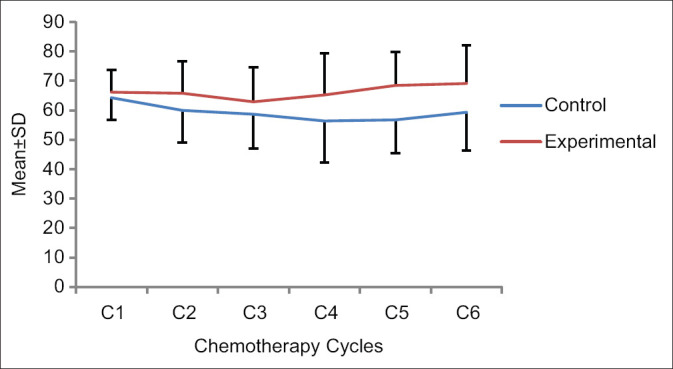
Global health status
The findings were supported by Andysz et al.[3] Their results revealed that the experimental group who practiced yoga displayed a statistically significant increase (P = 0.048) in the general health status and QOL scores in comparison to the control group. Shahriari et al.[4] reported a significant increase in the mean scores of overall QOL in the experimental group after intervention, in comparison to the control group. Yazdani[5] reported that the yoga group had a significant increase in mean GHS scores after intervention.
Functional scales
Physical function
The results revealed that physical function average scores of the control group decreased significantly from the baseline score in the second, third, fourth, fifth, and sixth cycles, showing a declining trend in scores. However, the average scores of the experimental group reduced significantly from the baseline score in the fourth cycle. Significant difference between the experimental and control groups was observed in the third, fifth, and sixth cycles (P = 0.007, P = 0.0002, and P = 0.0007, respectively) [Figure 2].
Figure 2.
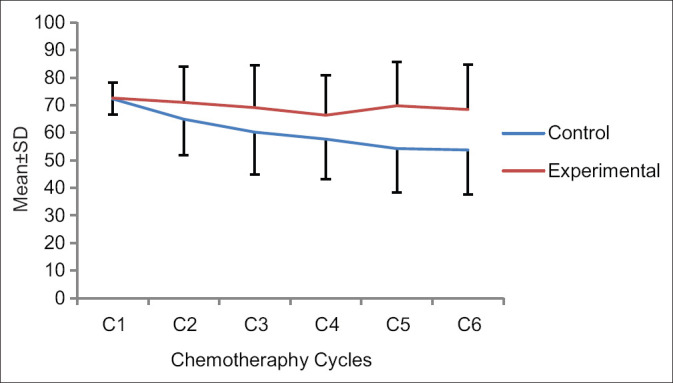
Physical function
Role function
A pattern of gradual decrease in the mean scores of role function was found in the control group from the baseline score (66.98 ± 14.19) in the second through the sixth (51.58 ± 20.76) cycles of chemotherapy. However, the experimental group's mean scores were similar to the baseline mean throughout all the six cycles. Significant difference between the experimental group and the control group was observed in the second, third, fourth, fifth, and sixth cycles of chemotherapy (P = 0.01, P = 0.03, P = 0.003, P = 0.0001, and P = 0.0003, respectively) [Figure 3].
Figure 3.
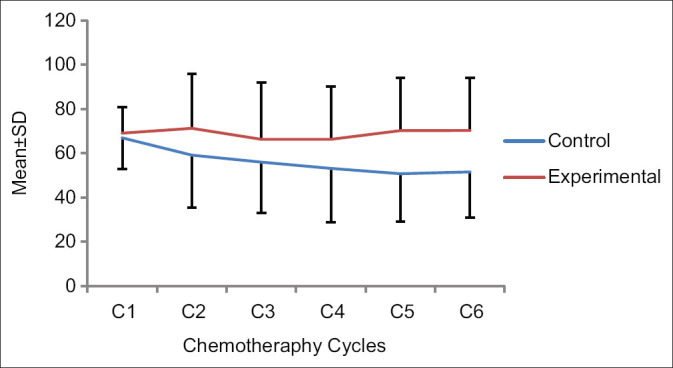
Role function
Emotional function
In the control group, a trend of decreasing mean scores of emotional functions was found from the baseline score (58. 81 ± 16.11) in the second through the sixth (44. 84 ± 25.36) cycles of chemotherapy. The experimental group also had a decrease in mean scores from the baseline score (60.41 ± 12.69) all through the second, third, and fourth (50.36 ± 10.53) cycles. A slight increase was observed in the fifth and sixth cycles of chemotherapy. The decrease in the emotional function scores was greater in the control group compared to the experimental group. Significant difference between the experimental and the control groups was observed in the sixth cycle (P = 0.05) [Figure 4].
Figure 4.
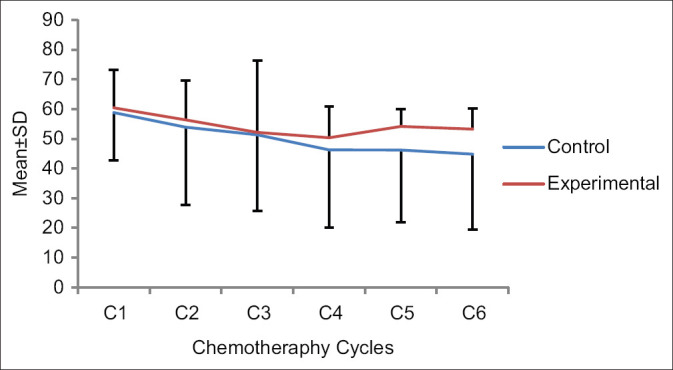
Emotional function
Cognitive function
The control group showed a gradual decrease in the mean scores of the cognitive function from the baseline score (93.26 ± 13.30) in the second through the sixth (62. 69 ± 30.97) cycles, which was statistically significant. The experimental group also showed a decrease in scores from the baseline (92.01 ± 11.90) in the second through the sixth (75.20 ± 23.31) cycles. A statistically significant differnce between the experimental group and the control group was observed in the fifth cycle (P = 0.03) [Figure 5].
Figure 5.
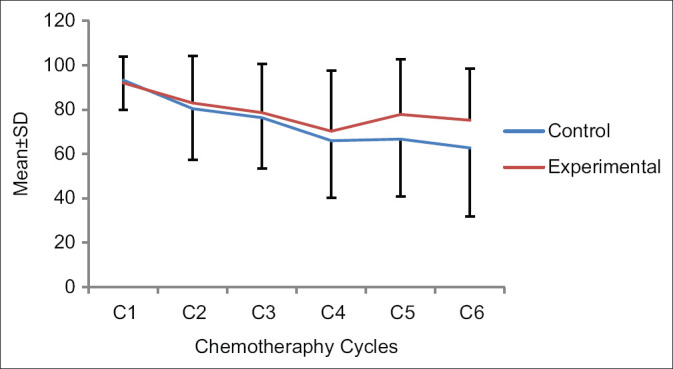
Cognitive function
Social function
Patients in the control group displayed a trend of decreasing mean scores of the social function from the baseline score (58. 33 ± 16.99) in the second through the sixth (37.69 ± 20.51) cycles of chemotherapy, which was statistically significant. The experimental group also showed a decrease in the mean score from the baseline (59.02 ± 14. 56) in the second through the fourth (41.30 ± 10.38) cycles. There was a little increase in the fifth and sixth (44.30 ± 12.69) cycles. No statistically significant difference between the experimental and the control groups was observed in any of the cycles [Figure 6].
Figure 6.
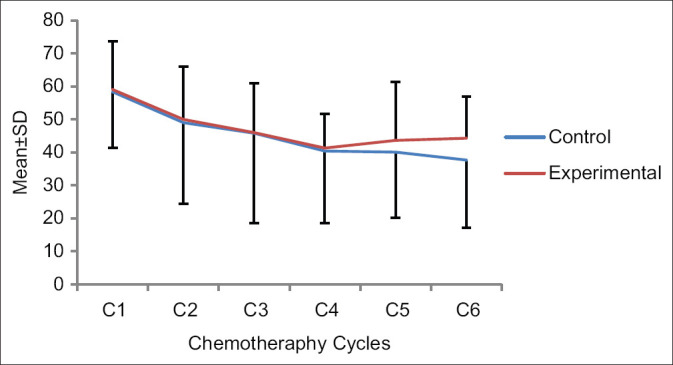
Social function
The results showed that yoga was effective in improving the physical, role, emotional, and cognitive functions of breast cancer patients who were practicing yoga. However, yoga had no effect on social function of these patients; basically social function was decreased due to alopecia caused by chemotherapy.
Symptom scale
Fatigue
The outcome revealed that patients in the control group had a greater increase in fatigue mean scores from the baseline score in the second through the sixth cycles, which was statistically significant. In the experimental group also, the fatigue scores increased significantly from the baseline score in the second through the sixth cycles of chemotherapy. A statistically significant difference between both group was noted in the second through the sixth cycles (P = 0.001, P = 0.002, P = 0.001, P = 0.0002, and P = 0.0000, respectively) [Figure 7].
Figure 7.
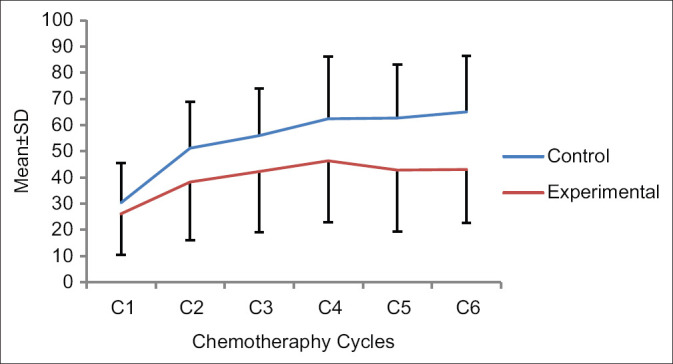
Fatigue
The results were supported by a study done by Bower et al.[6] Their findings revealed that the yoga group showed a significant decline in fatigue severity in follow-up after 3 months in comparison to the control group. Chakrabarty et al.[7] reported that participants in both groups exhibited a significant difference in the scores of tiredness caused by cancer. The experimental group who practiced breathing technique, called pranayama, felt less tiredness in comparison to the control group. Pathak et al.[8] reported statistically significant (P < 0.01) reduction in pre- to post-cancer-related fatigue in the progressive muscle relaxation group, while fatigue increased statistically significantly (P < 0.01) in the control group. Taso et al.[9] reported that yoga intervention significantly lowered the total fatigue scores and the disturbance of fatigue in the daily life of participants who belonged to the experimental group compared to the control group.
Nausea and vomiting
The results showed that the mean score of nausea and vomiting in the experimental and the control groups increased significantly from the baseline score in the second through the sixth cycles. The experimental group exhibited a statistically significant difference in comparison to the control group in cycle three (P = 0.02). As reported by the participants, nausea and vomiting were more prevalent, 2–3 days right after receiving chemotherapy. Because the data were collected in the 3rd week after chemotherapy, patients reported reduced symptoms of nausea and vomiting [Figure 8].
Figure 8.
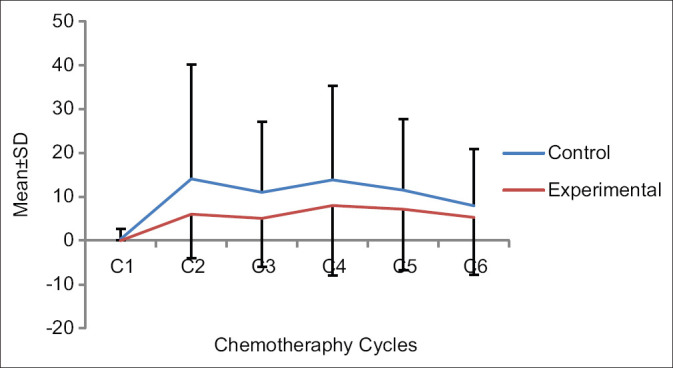
Nausea and vomiting
The results of the present study were supported by a randomized controlled trial done in Hong Kong by Molassiotis et al.[10] Their results revealed that relaxation of body muscles training reduced the interval of nausea and vomiting in patients who belonged to the experimental group in comparison to the control group. A trend of decline in the symptoms of nausea and vomiting was observed.
Pain
Patients in both groups had breast surgery before chemotherapy. Therefore, they reported having pain at the baseline with a mean score 25.32 ± 14.19 in the control group and 22.91 ± 14.83 in the experimental group. The pain scores increased significantly from the baseline score in the second, fifth, and the sixth cycles in the control group. However, in the experimental group, scores increased significantly in the fourth cycle only from the baseline score. The participants reported having pain in the muscles of lower extremities due to the side effects of chemotherapy. The difference between the pain scores of both groups was not significant during any of the cycles [Figure 9].
Figure 9.
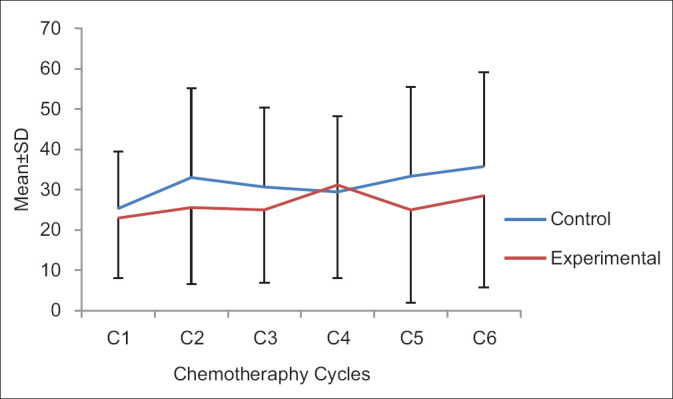
Pain
Dyspnea
The results revealed that at baseline, the dyspnea mean score was minimum (4.48 ± 11.48) in both the groups. The dyspnea score increased significantly in both groups during the second cycle. This might have been due to the decrease in hemoglobin level as a result of chemotherapy. In the control group, the dyspnea score decreased in the third cycle, increased in the fourth, and then decreased in the fifth cycle of chemotherapy. However, in the experimental group, the score decreased gradually from the third through the sixth cycles. The dyspnea scores of both groups did not differ significantly in any cycles [Figure 10].
Figure 10.
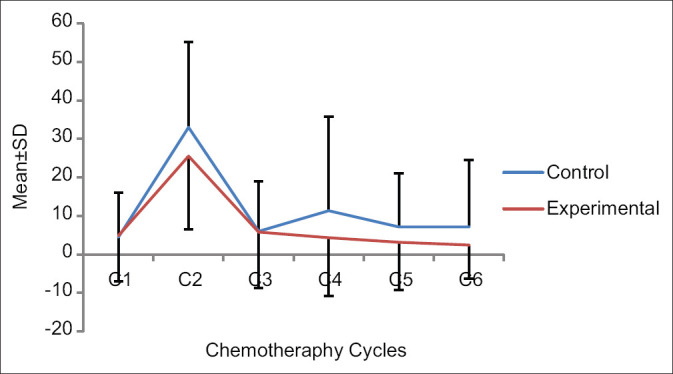
Dyspnea
Insomnia
The results revealed that in the experimental and control groups, the mean insomnia scores increased significantly from the baseline score in the second through the sixth cycles. A statistically significant difference between the both groups was observed in the fifth cycle (P = 0.01) [Figure 11].
Figure 11.
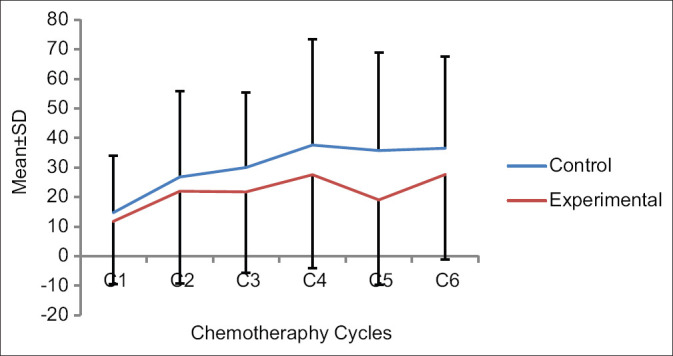
Insomnia
The results were consistent with a study done by Dhruva et al.[11] Their results revealed improvement in symptom and QOL scores, insomnia (P < 0.05), in the experimental group who practiced breathing technique in comparison to the control group. Mustian et al.[12] reported that yoga group exhibited more improvement in total sleep quality and other qualities of sleep in posttest in comparison to the control group.
Loss of appetite
The results showed that mean loss of appetite scores of experimental and control groups increased significantly from the baseline mean in the second through the sixth cycles. A statistically significant difference between the mean scores of both groups was observed in the second, fourth, fifth, and sixth cycles (P = 0.01, P = 0.006, P = 0.01, and P = 0.001, respectively) [Figure 12].
Figure 12.
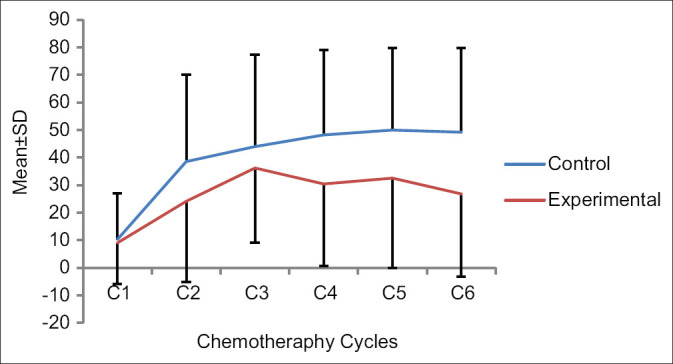
Loss of appetite
The results were consistent with a randomized trial done by Vadiraja et al.[13] They observed that the yoga group had a significant decline in fatigue and insomnia. The control group demonstrated a significantly higher loss of appetite. The yoga group had a significant decline in pain and vomiting scores after intervention.
Constipation
Patients in both groups reported that they had constipation. The mean scores of constipation of the experimental and control groups increased significantly from the baseline score in the second through the sixth cycles. The results revealed that patients experienced constipation throughout the period of chemotherapy. A statistically significant difference in the scores of both groups was observed in the third cycle (P = 0.03) [Figure 13].
Figure 13.
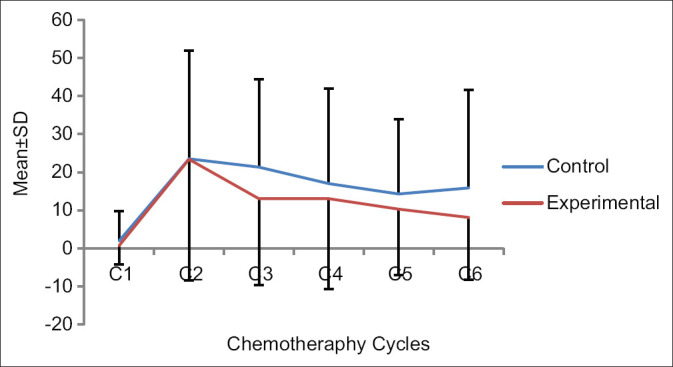
Constipation
Diarrhea
Statistically significant difference was not observed between the experimental and the control groups in any cycle [Figure 14].
Figure 14.
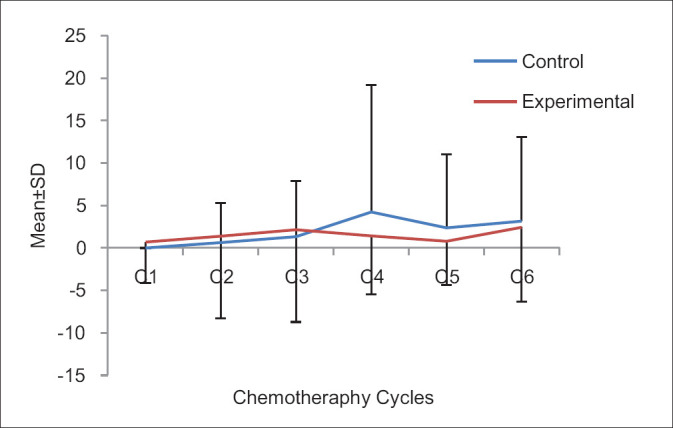
Diarrhea
Financial difficulty
Patients in the experimental and control groups experienced the same level of financial difficulty throughout the period of chemotherapy.
Limitations of the study
Assessment of the effectiveness of yoga on QOL and stress level of breast cancer patients receiving chemotherapy regimen was a challenging task. The patients' acceptance of yoga was very high. The study has the following limitations;
Yoga practiced by patients at home could not be monitored
The control group could not be taught yoga because of the nature of the study.
CONCLUSION
The findings of this research highlighted that yoga intervention was effective in breast cancer patients who were going through chemotherapy in:
Improving the QOL of breast cancer patients in the experimental group in the areas of GHS, physical function, role function, and emotional function
Decreasing the symptoms of fatigue, insomnia, loss of appetite, and constipation, during the period of chemotherapy.
Financial support and sponsorship
Nil.
Conflicts of interest
There are no conflicts of interest.
Acknowledgments
The study was conducted as part of PhD thesis at Swami Rama Himalayan University. The authors acknowledge support from the medical and nursing professionals from Cancer Research Institute and Yoga experts Dr. Kathleen M Mcheen R.N. PhD and Dr. John Clarke MD.
REFERENCES
- 1.Bray F, Ferlay J, Soerjomataram I, Siegel RL, Torre LA, Jemal A. Global cancer statistics 2018: GLOBOCAN estimates of incidence and mortality worldwide for 36 cancers in 185 countries. CA Cancer J Clin. 2018;68:394–424. doi: 10.3322/caac.21492. [DOI] [PubMed] [Google Scholar]
- 2.Johansson B, Brandberg Y, Hellbom M, Persson C, Petersson LM, Berglund G, et al. Health-related quality of life and distress in cancer patients: Results from a large randomised study. Br J Cancer. 2008;99:1975–83. doi: 10.1038/sj.bjc.6604789. [DOI] [PMC free article] [PubMed] [Google Scholar]
- 3.Andysz A, Merecz D, Wójcik A, Świątkowska B, Sierocka K, Najder A. Effect of a 10-week yoga programme on the quality of life of women after breast cancer surgery. Menop Rev. 2014;13(3):186–93. doi: 10.5114/pm.2014.43823. [DOI] [PMC free article] [PubMed] [Google Scholar]
- 4.Shahriari M, Dehghan M, Pahlavanzadeh S, Hazini A. Effects of progressive muscle relaxation, guided imagery and deep diaphragmatic breathing on quality of life in elderly with breast or prostate cancer. J Educ Health Promot. 2017;6:1. doi: 10.4103/jehp.jehp_147_14. [DOI] [PMC free article] [PubMed] [Google Scholar]
- 5.Yazdani F. The effects of yoga program on the quality of life in breast cancer patients. J Urmia Nurs Midwifery Faculty. 2014;12:6, 444–53. [Google Scholar]
- 6.Bower JE, Garet D, Sternlieb B, Ganz PA, Irwin MR, Olmstead R, et al. Yoga for persistent fatigue in breast cancer survivors: A randomized controlled trial. Cancer. 2012;118:3766–75. doi: 10.1002/cncr.26702. [DOI] [PMC free article] [PubMed] [Google Scholar]
- 7.Chakrabarty J, Vidyasagar M S, Fernandes D, Joisa G, Varghese P, Mayya S. Effectiveness of pranayama on cancer-related fatigue in breast cancer patients undergoing radiation therapy: A randomized controlled trial. Int J Yoga. 2015;8:47–53. doi: 10.4103/0973-6131.146062. [DOI] [PMC free article] [PubMed] [Google Scholar]
- 8.Pathak P, Mahal R, Kohli A, Nimbran V. Progressive muscle relaxation: An adjuvant therapy for reducing pain and fatigue among hospitalized cancer patients receiving radiotherapy. Int J Adv Nurs Stud. 2013;2:2, 58–65. [Google Scholar]
- 9.Taso CJ, Lin HS, Lin WL, Chen SM, Huang WT, Chen SW. The effect of yoga exercise on improving depression, anxiety, and fatigue in women with breast cancer: A randomized controlled trial. J Nurs Res. 2014;22(3):155–64. doi: 10.1097/jnr.0000000000000044. [DOI] [PubMed] [Google Scholar]
- 10.Molassiotis A, Yung HP, Yam BM, Chan FY, Mok T. He effectiveness of progressive muscle relaxation training in managing chemotherapy-induced nausea and vomiting in Chinese breast cancer patients: A randomised controlled trial. Supp Care Cancer. 2002;10(3):237–46. doi: 10.1007/s00520-001-0329-9. [DOI] [PubMed] [Google Scholar]
- 11.Dhruva A, Miaskowski C, Abrams D, Acree M, Cooper B, Goodman S, Hecht FM. Yoga breathing for cancer chemotherapy-associated symptoms and quality of life: Results of a pilot randomized controlled trial. J Alternat Complementary Med. 2012;18(5):473–9. doi: 10.1089/acm.2011.0555. [DOI] [PMC free article] [PubMed] [Google Scholar]
- 12.Mustian KM, Sprod LK, Janelsins M, Peppone LJ, Palesh OG, Chandwani K, et al. Multicenter, randomized controlled trial of yoga for sleep quality among cancer survivors. J Clin Oncol. 2013;31(26):3233–41. doi: 10.1200/JCO.2012.43.7707. [DOI] [PMC free article] [PubMed] [Google Scholar]
- 13.Vadiraja HS, Rao MR, Nagarathnaa R, Nagendraa HR, Rekhaa M, Vanithaa N, et al. Effects of yoga program on quality of life and affect in early breast cancer patients undergoing adjuvant radiotherapy: A randomized controlled trial. Compl Ther Med. 2009;17:5. doi: 10.1016/j.ctim.2009.06.004. [DOI] [PubMed] [Google Scholar]


